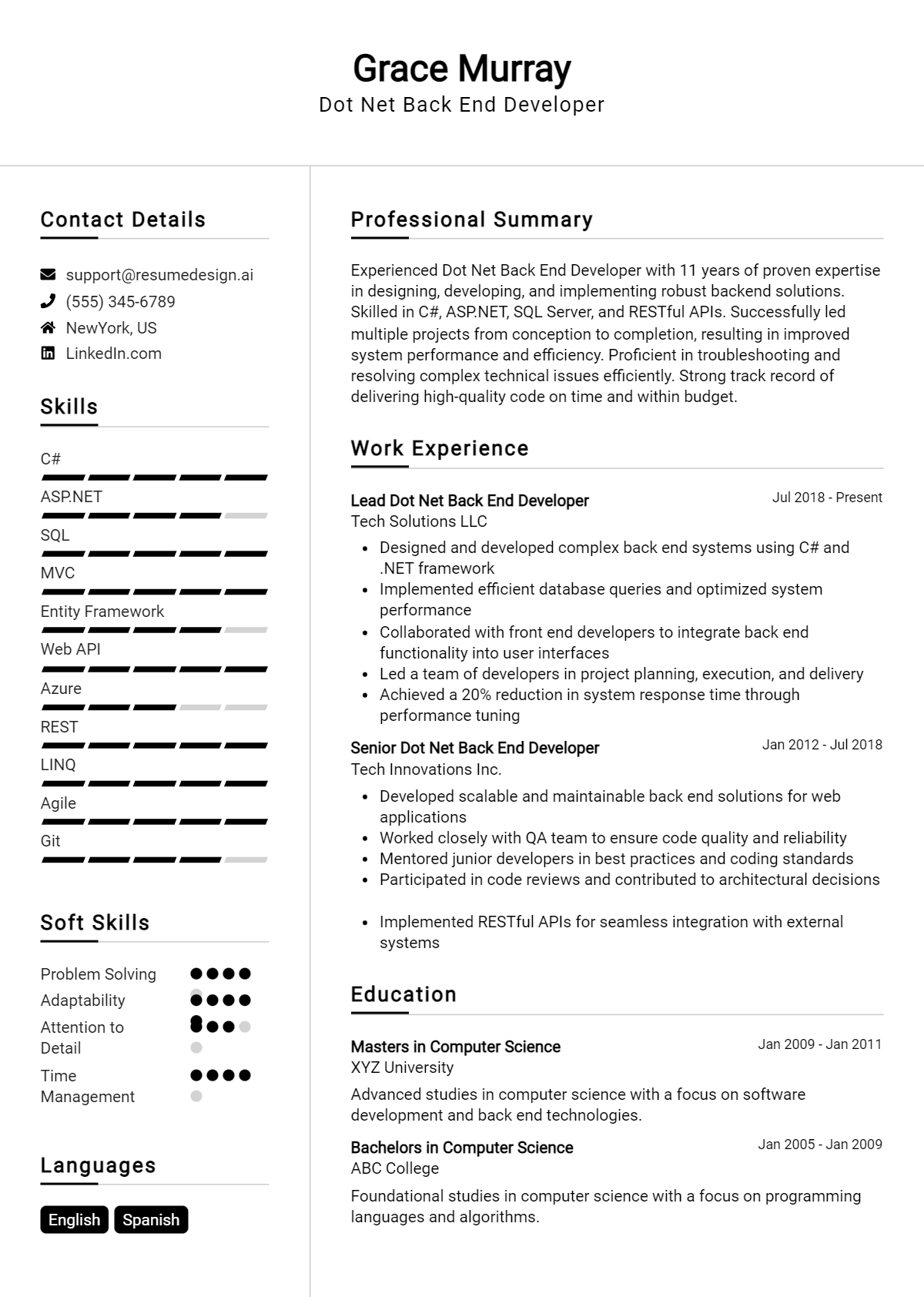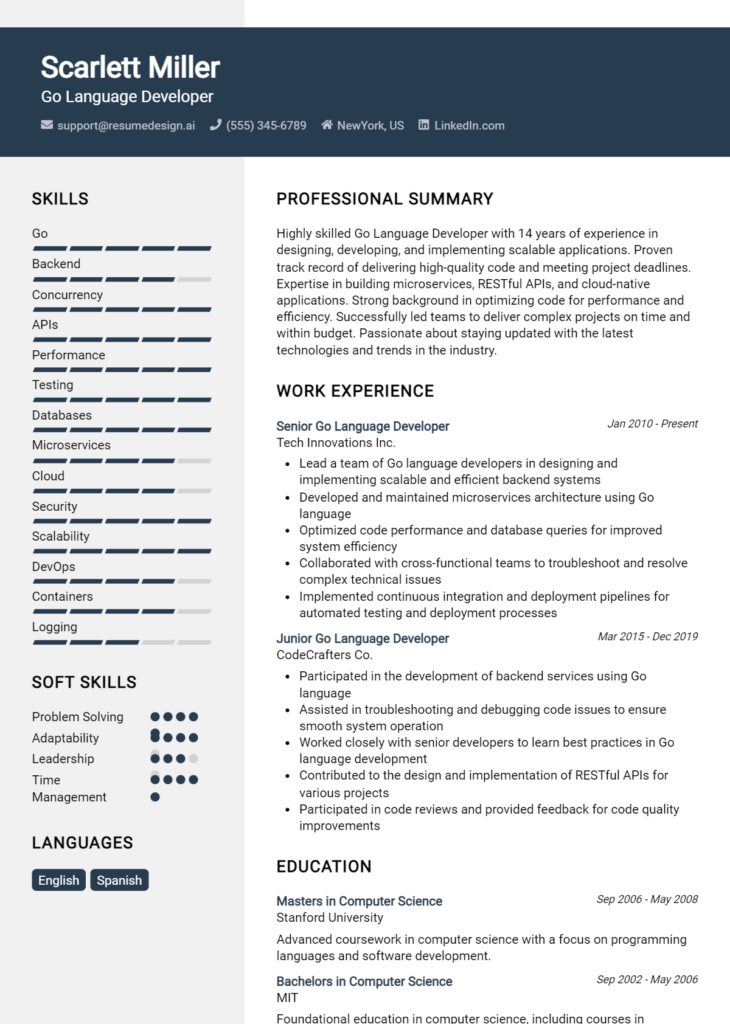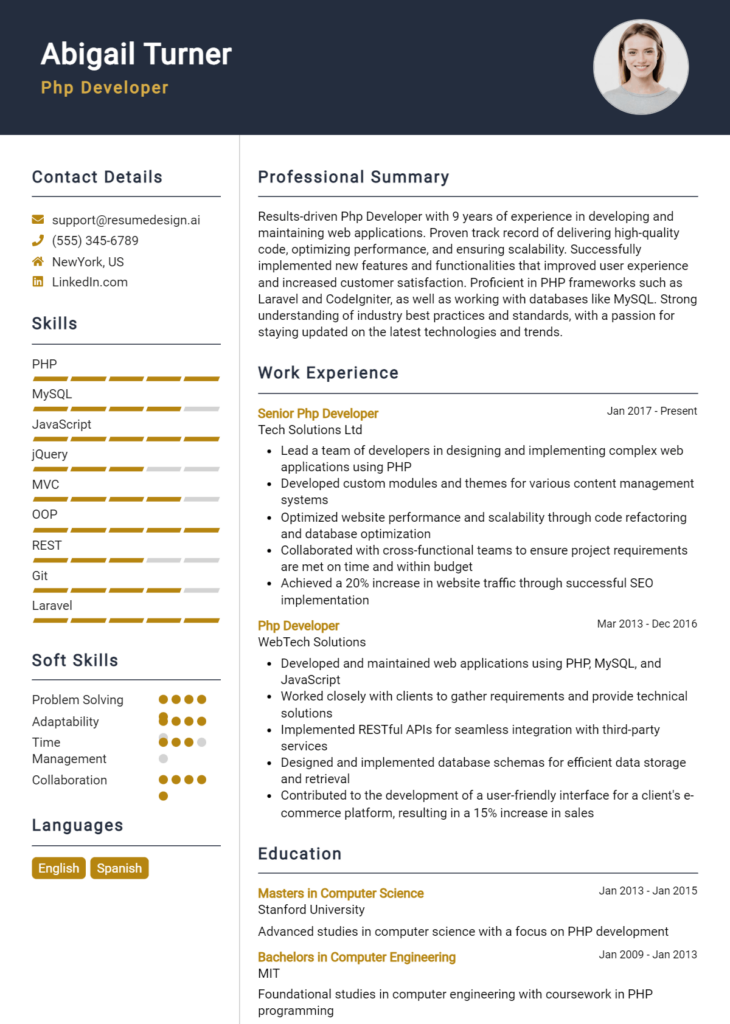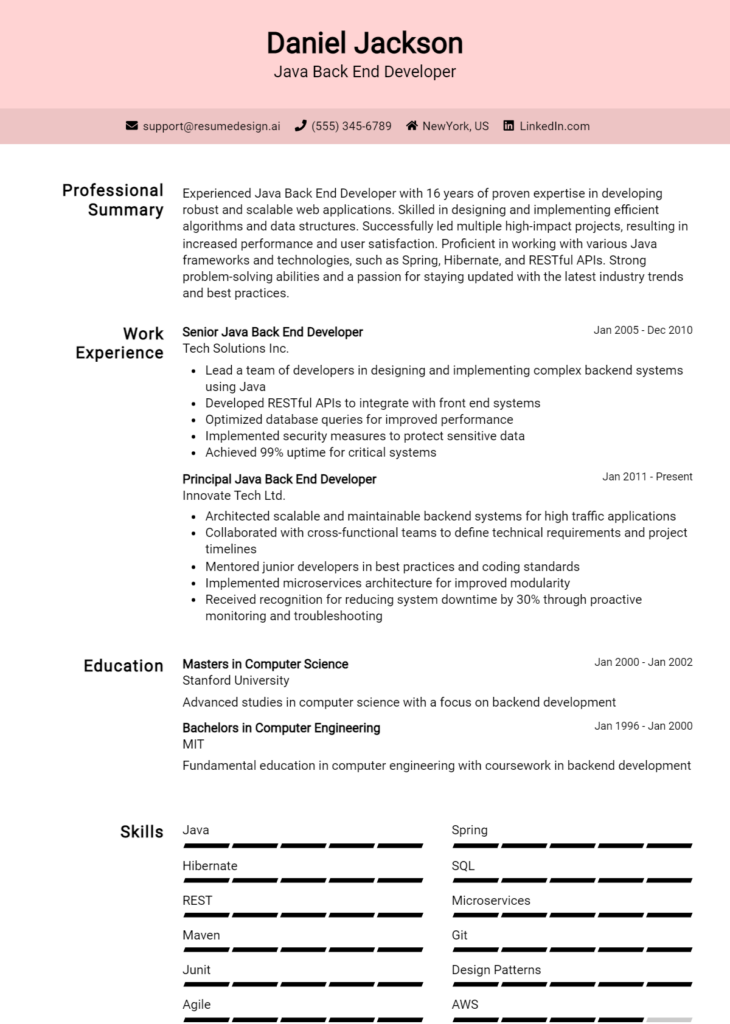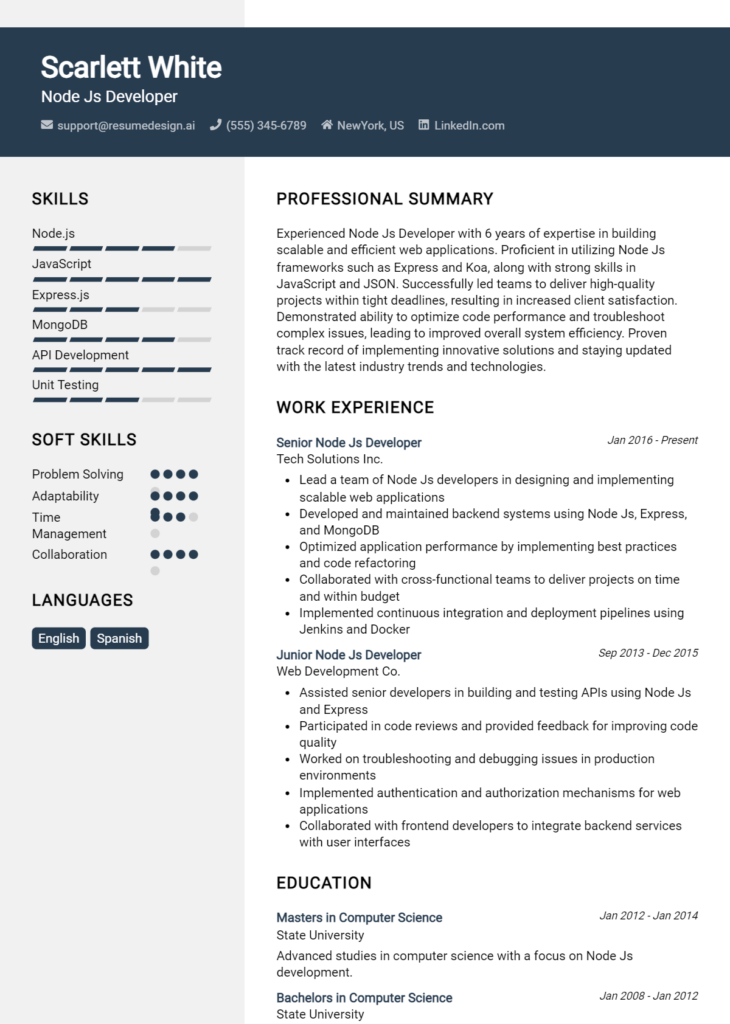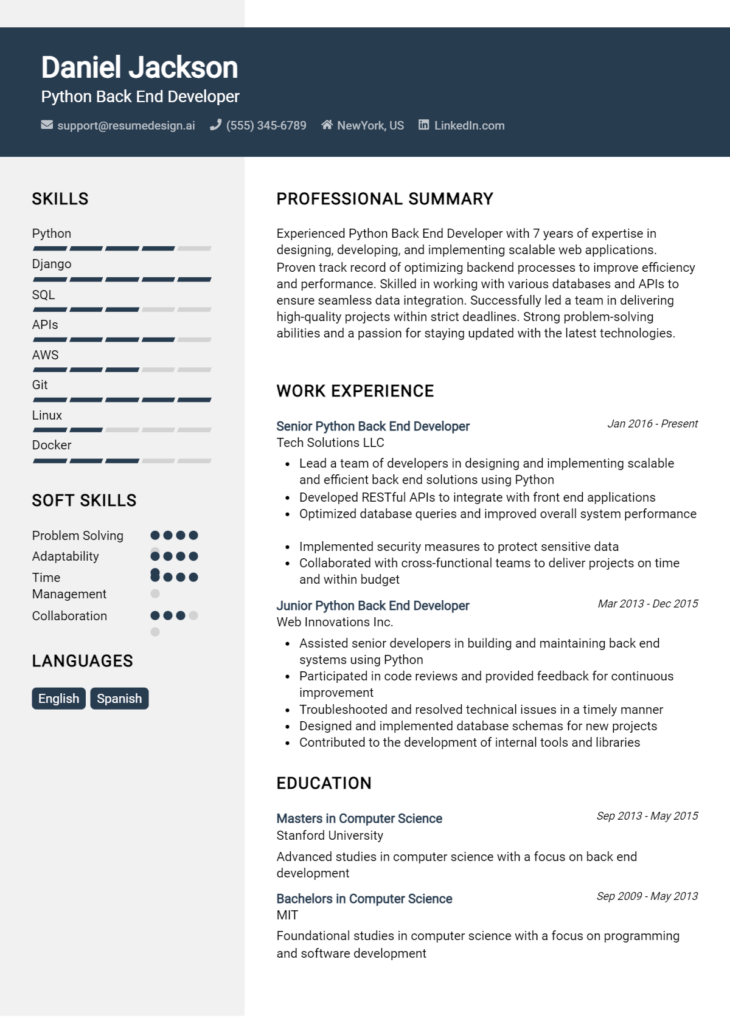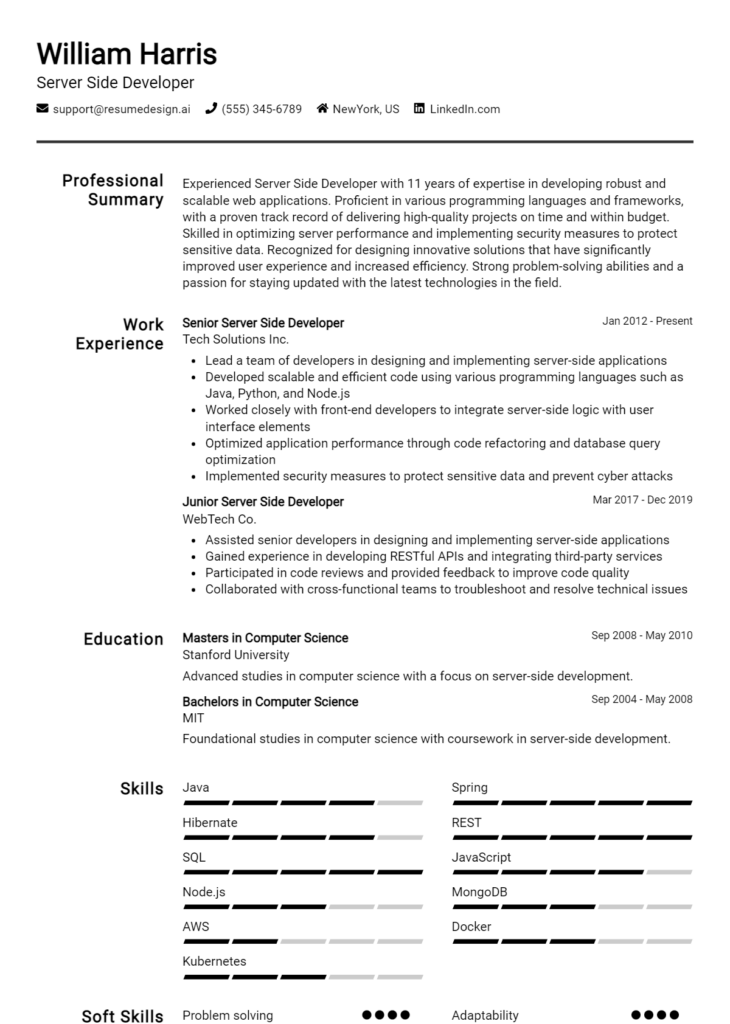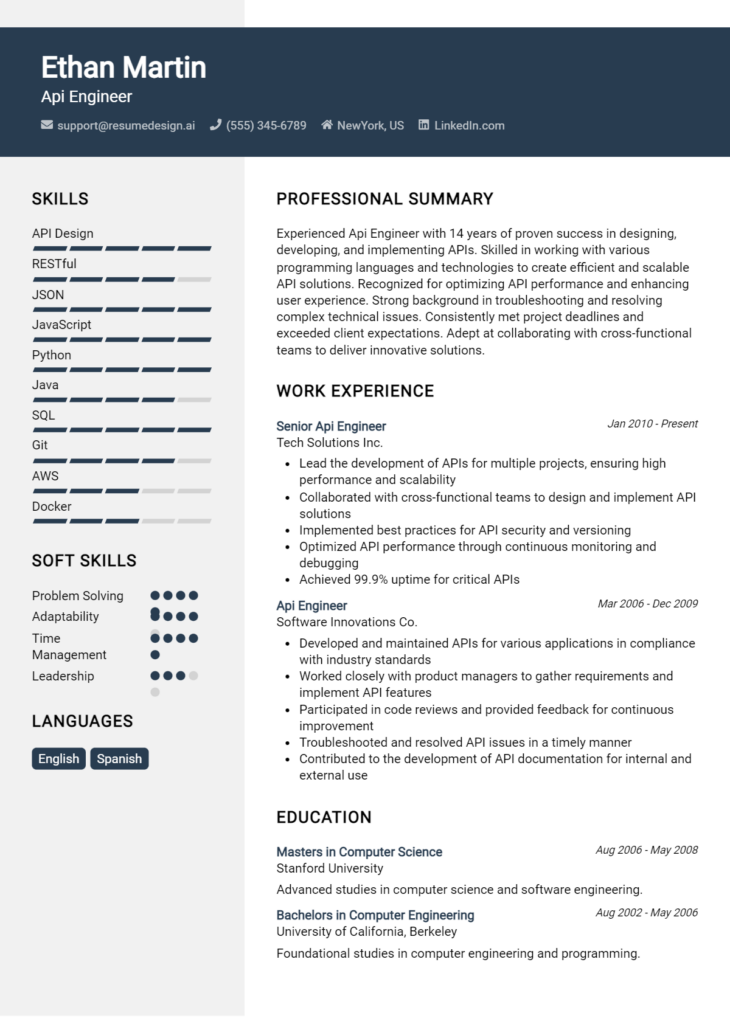dot NET Back-End Developer Core Responsibilities
A dot NET Back-End Developer plays a crucial role in creating and maintaining server-side applications, ensuring seamless data flow between front-end and back-end systems. Key responsibilities include designing APIs, managing databases, and collaborating with front-end developers and system architects. Technical skills in C#, SQL Server, and ASP.NET are essential, along with strong problem-solving and operational capabilities. These skills facilitate effective communication across departments, aligning technical solutions with organizational goals. A well-structured resume highlighting these qualifications can significantly enhance job prospects.
Common Responsibilities Listed on dot NET Back-End Developer Resume
- Developing and maintaining server-side applications using .NET technologies.
- Designing and implementing RESTful APIs for data exchange.
- Collaborating with front-end developers to integrate user-facing elements.
- Optimizing database queries and ensuring data integrity.
- Debugging and troubleshooting application issues efficiently.
- Writing unit tests to ensure code quality and reliability.
- Participating in code reviews and providing constructive feedback.
- Implementing security best practices to protect data.
- Documenting application architecture and design decisions.
- Staying updated with industry trends and emerging technologies.
- Contributing to the development of software design patterns and methodologies.
High-Level Resume Tips for dot NET Back-End Developer Professionals
In the competitive world of technology, a well-crafted resume is crucial for dot NET Back-End Developer professionals seeking to make a strong impression on potential employers. Your resume serves as the first point of contact, showcasing not only your technical skills but also your achievements and unique contributions to previous projects. It must effectively convey your capabilities and value to prospective employers, reflecting your proficiency in .NET technologies and your ability to solve complex problems. This guide will provide practical and actionable resume tips specifically tailored for dot NET Back-End Developer professionals, helping you stand out in a crowded job market.
Top Resume Tips for dot NET Back-End Developer Professionals
- Tailor your resume to the specific job description by including relevant keywords and phrases that align with the role.
- Highlight your technical skills prominently, focusing on .NET frameworks, database management, and programming languages you are proficient in.
- Showcase relevant work experience, detailing your role in projects, technologies used, and the impact of your contributions.
- Quantify your achievements where possible; use metrics to demonstrate how your work improved efficiency, reduced costs, or enhanced user experience.
- Include industry-specific certifications that validate your expertise in .NET development and related technologies.
- Demonstrate your problem-solving skills by providing examples of challenges you faced in previous roles and how you overcame them.
- Keep the design of your resume clean and professional, ensuring readability and easy navigation for hiring managers.
- Incorporate a brief summary at the top of your resume that encapsulates your experience and career goals as a dot NET Back-End Developer.
- Utilize bullet points to break down information, making it easier for employers to quickly scan and identify key qualifications.
By implementing these tips, you can significantly enhance your resume and increase your chances of landing a job in the dot NET Back-End Developer field. A well-structured and targeted resume not only highlights your capabilities but also demonstrates your commitment to professionalism and attention to detail, which are crucial traits for success in this industry.
Why Resume Headlines & Titles are Important for dot NET Back-End Developer
In the competitive field of software development, particularly for a dot NET Back-End Developer, a resume headline or title plays a crucial role in capturing the attention of hiring managers. A strong resume headline serves as a powerful first impression, summarizing a candidate's key qualifications and expertise in a concise and impactful phrase. It allows hiring managers to quickly assess the relevance of an applicant to the position, ensuring that the most pertinent skills and experiences are highlighted right from the outset. Crafting a headline that is both relevant and succinct is essential for standing out among a pool of candidates and making a lasting impression.
Best Practices for Crafting Resume Headlines for dot NET Back-End Developer
- Keep it concise: Aim for one impactful phrase that captures your core qualifications.
- Be role-specific: Tailor the headline to reflect the exact position you are applying for.
- Highlight key skills: Include specific technologies or frameworks relevant to dot NET development.
- Showcase accomplishments: Use metrics or achievements to demonstrate your impact in previous roles.
- Avoid jargon: Use clear language that is easily understood by hiring managers and ATS.
- Use action words: Start with strong verbs to convey your capabilities and expertise.
- Align with job description: Mirror the language and requirements found in the job posting.
- Stay professional: Maintain a formal tone that reflects your seriousness about the role.
Example Resume Headlines for dot NET Back-End Developer
Strong Resume Headlines
"Experienced dot NET Back-End Developer | Expertise in ASP.NET Core and SQL Server"
“Results-Driven dot NET Developer | Proven Track Record in Delivering Scalable Solutions”
“Innovative Back-End Developer | Specializing in Microservices Architecture and Cloud Integration”
Weak Resume Headlines
“Developer Looking for a Job”
“Experienced IT Professional”
Strong headlines are effective because they immediately convey the candidate's specific skills, experience, and value, making it easy for hiring managers to see how they align with the job requirements. In contrast, weak headlines tend to be vague or generic, lacking the detail and specificity needed to capture interest. They fail to differentiate the candidate in a crowded field, ultimately diminishing the chances of making a positive impression and advancing in the hiring process.
Writing an Exceptional dot NET Back-End Developer Resume Summary
A well-crafted resume summary is crucial for a dot NET Back-End Developer as it serves as the first impression a hiring manager will have of a candidate's qualifications. A strong summary quickly captures attention by showcasing key skills, relevant experience, and notable accomplishments that align with the job role. This concise and impactful introduction should be tailored to the specific job application, emphasizing the candidate’s technical proficiencies and contributions that can add value to the prospective employer.
Best Practices for Writing a dot NET Back-End Developer Resume Summary
- Quantify achievements: Use numbers to highlight your contributions, such as performance improvements or project completions.
- Focus on relevant skills: Tailor your summary to emphasize technical skills like C#, ASP.NET, SQL Server, and cloud technologies.
- Keep it concise: Aim for 3-5 sentences that encapsulate your experience and value without overwhelming the reader.
- Use action verbs: Begin sentences with strong action words to convey energy and proactivity.
- Highlight unique contributions: Mention any unique skills or experiences that set you apart from other candidates.
- Align with the job description: Refer to keywords and requirements in the job posting to ensure your summary meets the employer’s expectations.
- Showcase problem-solving abilities: Include examples of how you've addressed challenges or improved processes in past roles.
- Update regularly: Revise your summary as you gain more experience or shift your career focus to keep it relevant.
Example dot NET Back-End Developer Resume Summaries
Strong Resume Summaries
Results-driven dot NET Back-End Developer with over 5 years of experience in building scalable web applications. Successfully improved application performance by 30% through optimizing database queries and implementing caching strategies in ASP.NET Core.
Detail-oriented software engineer skilled in C# and SQL Server, with a proven track record of delivering high-quality software solutions. Spearheaded a project that reduced server response time by 25%, enhancing user experience across multiple platforms.
Innovative dot NET Back-End Developer with expertise in RESTful API development and cloud integration. Played a key role in migrating legacy systems to cloud-based solutions, resulting in a 40% cost reduction in infrastructure expenses.
Weak Resume Summaries
Experienced developer looking for a challenging position in a reputable company. Familiar with various technologies and languages.
Skilled in dot NET and other programming languages. I am a team player and eager to learn new things.
The examples of strong resume summaries effectively convey specific achievements and relevant skills, showcasing the candidate's value to potential employers. They include quantifiable results and are tailored to the dot NET Back-End Developer role. In contrast, the weak summaries are vague and generic, failing to provide any concrete examples of accomplishments or specific skills that would capture the hiring manager's attention.
Work Experience Section for dot NET Back-End Developer Resume
The work experience section of a dot NET Back-End Developer resume is critical as it not only highlights the candidate's technical skills but also illustrates their ability to manage teams effectively and deliver high-quality products. This section serves as a platform for candidates to showcase their previous roles and responsibilities, demonstrating their expertise in .NET technologies, frameworks, and methodologies. By quantifying achievements and aligning their experiences with industry standards, candidates can provide potential employers with a clear understanding of their capabilities and the value they bring to the organization.
Best Practices for dot NET Back-End Developer Work Experience
- Clearly state your role and responsibilities in each position, emphasizing relevant .NET technologies.
- Quantify achievements with metrics, such as improved performance, reduced costs, or increased user engagement.
- Highlight technical skills utilized in each role, including specific frameworks like ASP.NET, Entity Framework, or cloud services.
- Showcase collaboration and teamwork by mentioning cross-functional projects or team leadership experiences.
- Use action verbs to convey a sense of initiative and impact in your work.
- Align your experiences with industry standards and best practices, highlighting adherence to Agile or DevOps methodologies.
- Focus on outcomes and results rather than just tasks performed, demonstrating how your contributions led to successful project completions.
- Tailor your experience section for each application to match the job description and requirements closely.
Example Work Experiences for dot NET Back-End Developer
Strong Experiences
- Led a team of 5 developers to design and implement a microservices architecture, resulting in a 40% reduction in application downtime.
- Developed a RESTful API using ASP.NET Core that improved data retrieval speeds by 30%, enhancing overall application performance.
- Collaborated with cross-functional teams to migrate legacy systems to cloud-based solutions, reducing hosting costs by 25% annually.
- Implemented automated testing processes that decreased bug resolution time by 50%, significantly improving product quality.
Weak Experiences
- Worked on various projects using .NET technologies.
- Assisted in fixing bugs and issues in applications.
- Participated in team meetings and discussions.
- Involved in development tasks and code reviews.
The examples categorized as strong are considered effective because they provide specific details about the candidate's contributions, include quantifiable metrics that demonstrate impact, and showcase leadership and collaboration skills. In contrast, the weak experiences lack specificity, fail to quantify outcomes, and do not convey a clear sense of the candidate's contributions or achievements, which diminishes their effectiveness in showcasing the candidate's capabilities.
Education and Certifications Section for dot NET Back-End Developer Resume
The Education and Certifications section of a dot NET Back-End Developer resume is a crucial element that showcases a candidate's academic foundation and commitment to professional growth. This section not only highlights the educational qualifications that are relevant to the field, but also emphasizes industry-recognized certifications that validate the candidate's technical skills. By providing details about relevant coursework, specialized training, and ongoing education initiatives, applicants can significantly enhance their credibility and demonstrate their alignment with the demands of the job role. In a competitive job market, a well-structured Education and Certifications section can set a candidate apart, portraying them as a dedicated professional eager to stay updated with the latest technologies and best practices in dot NET development.
Best Practices for dot NET Back-End Developer Education and Certifications
- Include only relevant degrees and certifications that pertain to dot NET development.
- List certifications in order of relevance, prioritizing those recognized within the industry.
- Provide details about specific coursework that aligns with back-end development skills.
- Highlight any continuing education courses or workshops attended recently.
- Be precise with dates and institutions to establish credibility.
- Use clear headings and bullet points for easy readability.
- Consider including online learning platforms and courses that showcase adaptability to new technologies.
- Regularly update this section to reflect new certifications or educational experiences.
Example Education and Certifications for dot NET Back-End Developer
Strong Examples
- Bachelor of Science in Computer Science, XYZ University, Graduated May 2021
- Microsoft Certified: Azure Developer Associate, Issued June 2022
- Coursework in Advanced C# Programming, XYZ University
- Certified ScrumMaster (CSM), Issued January 2023
Weak Examples
- Associate Degree in General Studies, ABC Community College, Graduated June 2018
- Certification in HTML and CSS from an outdated online platform, Completed 2015
- Basic Computer Skills Course, Completed August 2019
- High School Diploma, Graduated 2016
The examples provided illustrate the distinction between strong and weak qualifications in the context of a dot NET Back-End Developer. Strong examples are directly relevant to the position, showcasing specific skills, certifications, and coursework that demonstrate the candidate's readiness and knowledge in back-end development. In contrast, weak examples lack relevance to the role, highlighting outdated or overly general qualifications that do not contribute to the candidate's credibility or suitability for a specialized position in dot NET development.
Top Skills & Keywords for dot NET Back-End Developer Resume
In the competitive landscape of software development, a well-crafted resume for a dot NET Back-End Developer is crucial for standing out among potential candidates. One of the most significant components of this resume is the inclusion of relevant skills—both hard and soft—that demonstrate a candidate's capability to contribute effectively to a development team. Highlighting the right skills not only showcases technical proficiency but also illustrates interpersonal qualities that are vital for collaboration and problem-solving in a dynamic work environment. As the demand for dot NET developers continues to rise, having an impressive skill set can set a candidate apart and make them more appealing to employers.
Top Hard & Soft Skills for dot NET Back-End Developer
Soft Skills
- Problem-Solving
- Team Collaboration
- Communication
- Adaptability
- Time Management
- Critical Thinking
- Attention to Detail
- Creativity
- Leadership
- Conflict Resolution
Hard Skills
- Proficiency in C# and .NET Framework
- Experience with ASP.NET and MVC
- Database Management (SQL Server, MySQL)
- API Development and Integration
- Understanding of RESTful services
- Knowledge of Entity Framework
- Familiarity with Cloud Services (Azure, AWS)
- Version Control Systems (Git)
- Unit Testing and Debugging
- Agile/Scrum Methodologies
For a deeper dive into the importance of showcasing your skills, check out this comprehensive guide on skills. Additionally, complementing these skills with relevant work experience can significantly enhance your resume's impact.
Stand Out with a Winning dot NET Back-End Developer Cover Letter
Dear [Hiring Manager's Name],
I am writing to express my interest in the Dot NET Back-End Developer position at [Company Name] as advertised on [Where You Found the Job Posting]. With a strong foundation in C#, ASP.NET, and SQL Server, coupled with my passion for developing robust and scalable applications, I am excited about the opportunity to contribute to your team. My experience in crafting efficient back-end solutions and my commitment to best practices in software development make me a strong candidate for this role.
In my previous position at [Previous Company Name], I successfully led a project to redesign the back-end architecture of a high-traffic web application, resulting in a 30% improvement in response times and a significant reduction in server load. I am adept at working with RESTful APIs and integrating third-party services, ensuring seamless communication between front-end and back-end systems. My collaborative approach to development, combined with my problem-solving skills, allows me to work effectively with cross-functional teams to deliver outstanding results.
I am particularly drawn to [Company Name] because of its commitment to innovation and quality in software development. I admire your focus on using cutting-edge technologies to solve real-world problems, and I am eager to bring my expertise in .NET development to your organization. I am confident that my technical skills and my enthusiasm for continuous learning will enable me to make meaningful contributions to your projects while also growing alongside your talented team.
Thank you for considering my application. I look forward to the possibility of discussing how my background, skills, and passions align with the goals of [Company Name]. I am excited about the opportunity to help create exceptional software solutions that drive success for your clients and users.
Sincerely,
[Your Name]
[Your LinkedIn Profile]
[Your Contact Information]
Common Mistakes to Avoid in a dot NET Back-End Developer Resume
When crafting a resume for a dot NET Back-End Developer position, it's crucial to present your skills and experiences effectively. Many candidates make common mistakes that can undermine their qualifications and reduce their chances of landing an interview. By being aware of these pitfalls, you can create a more compelling resume that highlights your technical expertise and demonstrates your fit for the role. Below are some common mistakes to avoid:
Generic Objective Statements: Using vague or general objectives can diminish the impact of your resume. Tailor your objective to reflect your specific skills and the role you are applying for.
Lack of Quantifiable Achievements: Failing to include measurable results from previous projects can make your contributions seem less significant. Use metrics to showcase your impact, such as "improved application performance by 30%."
Ignoring Relevant Keywords: Many companies use Applicant Tracking Systems (ATS) to filter resumes. Not incorporating relevant keywords from the job description can lead to your resume being overlooked.
Overly Complex Language: While technical expertise is important, using jargon or overly complex language can alienate hiring managers. Keep your descriptions clear and accessible.
Neglecting Soft Skills: Focusing solely on technical skills and ignoring soft skills, like teamwork or communication, can give an incomplete picture of your candidacy. Highlight how you’ve collaborated with others in your previous roles.
Poor Formatting: A cluttered or unprofessional layout can distract from your qualifications. Use clear headings, bullet points, and consistent font styles to enhance readability.
Inconsistent Employment History: Gaps in employment or inconsistent job titles can raise red flags. If you have gaps, briefly explain them or focus on relevant freelance or volunteer work.
Omitting Continuous Learning: The tech field evolves rapidly, and neglecting to mention ongoing education or certifications can signal a lack of initiative. Include relevant courses, certifications, or technologies you are currently learning to show your commitment to professional growth.
Conclusion
As a dot NET Back-End Developer, it's essential to highlight your technical skills, experience, and contributions to projects effectively in your resume. Throughout this article, we've discussed the importance of showcasing your proficiency in languages such as C#, ASP.NET, and SQL, as well as emphasizing your understanding of software development methodologies and frameworks.
Additionally, we touched on the significance of including relevant certifications and any experience with cloud services, which can give you a competitive edge in the job market. Remember that your resume should not only reflect your technical abilities but also your problem-solving skills and capacity to work collaboratively in a team environment.
To ensure your resume stands out, take the time to review and refine it based on the insights shared. Utilize the various resources available to you, such as resume templates, which can give you a professional layout, or the resume builder to customize your content easily. You can also explore resume examples for inspiration and see how other successful dot NET Back-End Developers present their qualifications. Don't forget to enhance your application further with polished cover letter templates.
Take action now—review your dot NET Back-End Developer resume and make the necessary updates to increase your chances of landing your dream job!

